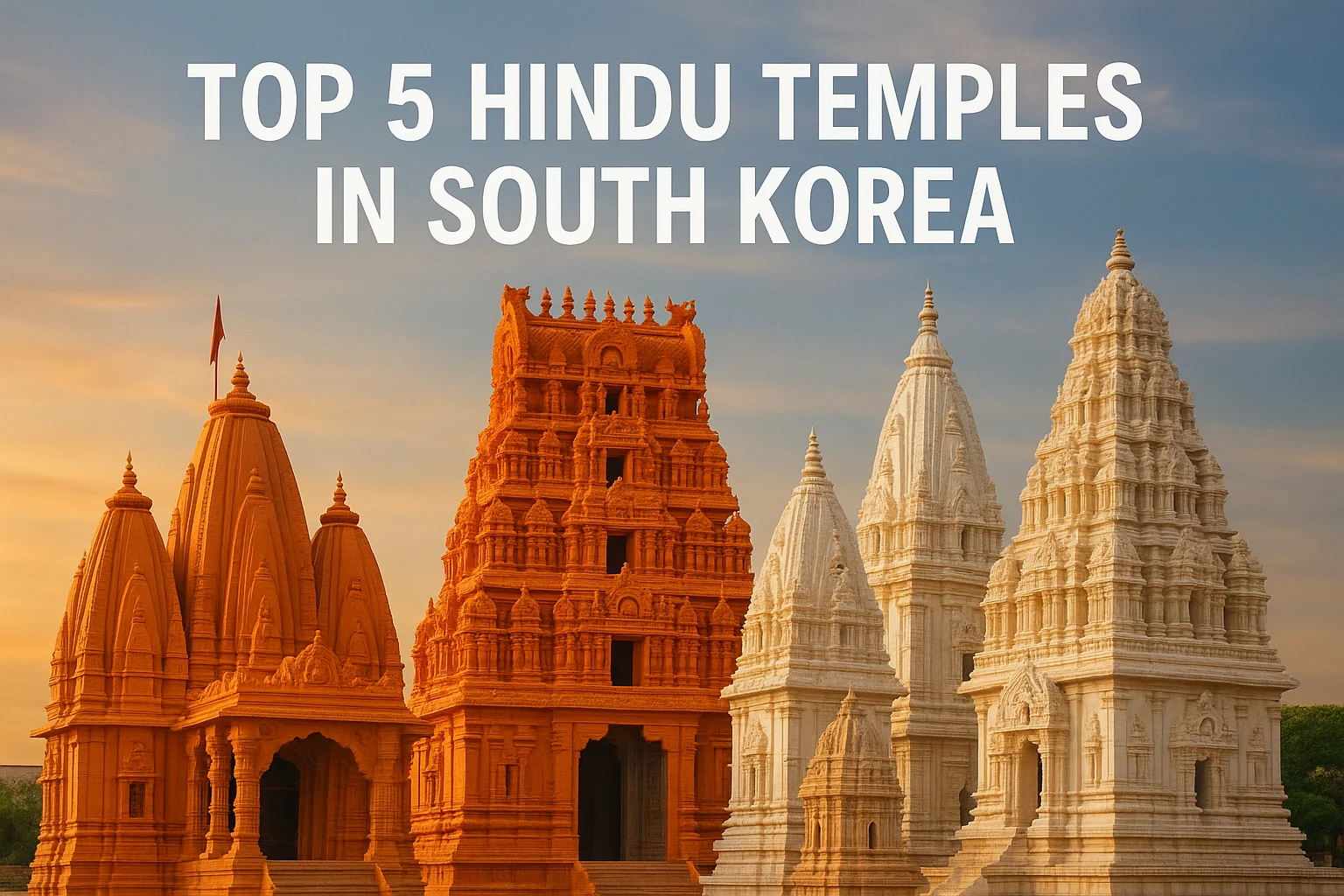Hindu temples in South Korea serve as important cultural and spiritual centers for the growing Indian community and local Korean devotees.
These temples provide spaces for religious practices, cultural celebrations, and community gatherings.
South Korea hosts several Hindu temples that maintain authentic traditions while integrating into the local landscape.
This article presents the top five Hindu temples in South Korea based on historical significance, architectural beauty, religious importance, and visitor experiences.
1. Sri Radha Shyamasundar Mandir (Seoul)

About the temple
Located in Haebangchon, Seoul, this ISKCON-affiliated temple is dedicated to Lord Krishna and Goddess Radha.
It offers daily worship services, children’s classes, yoga sessions, and hosts major Hindu festivals, serving as a cultural and spiritual hub for the community.
Location and Accessibility
Situated near Itaewon, the temple is easily accessible via the Itaewon subway station (Line 6), followed by a short walk.
It’s also reachable by bus, making it convenient for both locals and visitors.
Address: 44-8 Basement, Yongsan-2ga, Seoul, South Korea
History and Establishment
Established in 2008, the temple was founded by devotees inspired by A.C. Bhaktivedanta Swami Prabhupada‘s teachings, aiming to spread Sanatana Dharma in Korea and provide a spiritual sanctuary for the Hindu community.
Temple Architecture
The temple features traditional Hindu design elements, including intricate carvings and vibrant deities, creating a serene and welcoming atmosphere for devotees and visitors alike.
Religious Activities
Conducts Mangal Aarti, Sandhya Aarti, Bhagavad Gita classes, children’s Bal Vikas programs, and hosts major Hindu festivals like Diwali and Janmashtami, attracting a diverse group of devotees.
Cultural Significance
Serves as a cultural center promoting Hindu traditions and values, fostering a sense of community among devotees from India, Nepal, Bangladesh, Sri Lanka, Pakistan, and local Koreans, and offering vegetarian groceries and puja items.
🛕 2. Sri Sri Radha Krishna Temple (Uijeongbu)

About the temple
An ISKCON-affiliated temple located in Pocheon-si, Gyeonggi Province, dedicated to Lord Krishna and Goddess Radha.
It offers various spiritual programs, including lectures, yoga classes, and community services, fostering a vibrant community of devotees.
Location and Accessibility
Accessible via Seoul Metropolitan Subway Line 1, heading towards Soyosan station.
After alighting at Uijeongbu station, a short taxi ride or bus (routes 138 or 72) will take you to the temple, approximately 20–30 minutes away.
Address: 17-19 Araennyongsang 2-gil, Soheul-eup, Pocheon-si, Gyeonggi-do, South Korea
History and Establishment
Founded by ISKCON to spread the teachings of Lord Krishna in Korea, serving as a spiritual hub for devotees and promoting the practice of bhakti yoga and the study of sacred texts.
Temple Architecture
Reflects traditional ISKCON temple architecture with vibrant deities and a peaceful ambiance, providing a serene environment for worship and reflection.
Religious Activities
Offers morning and evening Aartis, Bhagavad Gita study groups, community feasts, and celebrates major Hindu festivals, attracting devotees from various regions.
Cultural Significance
Acts as a hub for the Hindu community in northern Korea, fostering spiritual growth, cultural exchange, and promoting the values of compassion, service, and devotion.
Also Read : The Land of Temples in India
🛕 3. Sri Lakshmi Narayanan Temple (Seoul)
About the temple
Located in the metropolitan area of Seoul, this temple is dedicated to Lord Vishnu and Goddess Lakshmi.
It serves as a worship place for the Hindu community, providing a space for spiritual solace and community gatherings.
Location and Accessibility
Situated in central Seoul, the temple is easily accessible by public transportation, including subway and bus services, making it convenient for devotees and visitors to reach.
Address: Near Seoul Station
History and Establishment
Established to cater to the religious needs of the Hindu community in Seoul, providing a space for worship, cultural activities, and fostering a sense of community among devotees.
Temple Architecture
Traditional Hindu temple architecture with intricate carvings and serene surroundings, creating a tranquil environment for devotees to engage in worship and reflection.
Religious Activities
Regular prayers, festivals, and cultural programs, including Yoga and Vedanta sessions, fostering spiritual growth and community engagement among devotees.
Cultural Significance
Plays a vital role in preserving and promoting Hindu culture and traditions in Korea, serving as a beacon for devotees and visitors alike, and contributing to the multicultural fabric of South Korean society.
🛕 4. Himalayan Meditation and Yoga Sadhana Mandir (Seocho, Seoul)
About the temple
An affiliate center of the Association of Himalayan Yoga Meditation Societies International, focusing on meditation and yoga practices.
It offers a serene environment for spiritual seekers to deepen their practice and connect with their inner selves.
Location and Accessibility
Located in the Seocho district of Seoul, accessible via subway and bus, making it convenient for individuals interested in deepening their spiritual journey through traditional Hindu practices.
Address: 51, Baekbaemi-gil, Socho-myeon, Wonju-si, Gangwon-do, 26304, South Korea
History and Establishment
Founded to promote the teachings of Himalayan yoga and meditation in Korea, providing a space for individuals to explore and practice ancient spiritual disciplines in a supportive environment.
Temple Architecture
Simple and serene, designed to facilitate meditation and spiritual practices, with a focus on creating a peaceful environment conducive to self-reflection and inner peace.
Religious Activities
Yoga classes, meditation sessions, and spiritual retreats, offering opportunities for individuals to connect with their inner selves and deepen their understanding of Hindu philosophy.
Cultural Significance
Offers a space for spiritual seekers to deepen their practice and understanding of Hindu philosophy, contributing to the multicultural tapestry of South Korea and promoting holistic well-being.
5. Busan Hindu Samaj Temple
The Busan Hindu Samaj Temple serves the Hindu community in South Korea’s second-largest city.
Location and Accessibility
The temple is located in the Haeundae district of Busan. The nearest subway station is Haeundae Beach Station (Line 2).
Address: 52-14 Songjeong-dong, Haeundae-gu, Busan, South Korea
History and Establishment
Indian expatriates in Busan established this temple in 2011. The temple received support from local Korean businesses with Indian connections.
The facility expanded in 2018 to accommodate growing attendance.
Temple Architecture
The temple operates in a renovated building with Hindu architectural elements.
The main hall contains statues of major deities including Lord Ganesha, Lord Shiva, and Goddess Lakshmi.
The temple maintains a small garden with traditional plant varieties.
Religious Activities
Priests conduct weekly ceremonies on Saturdays and Sundays.
The temple organizes special pujas during important Hindu occasions. Devotional singing groups meet regularly at the temple.
Cultural Significance
The temple celebrates regional and national Indian festivals:
- Onam (Kerala festival)
- Baisakhi (Punjabi festival)
- Durga Puja (Bengali festival)
The temple runs weekend classes teaching Hindi and Sanskrit to children. Cultural exchange programs with local Korean institutions occur throughout the year.
Visiting Hindu Temples in South Korea
Visitor Etiquette
Visitors should follow these guidelines when visiting Hindu temples in South Korea:
- Remove shoes before entering temple premises
- Dress modestly, covering shoulders and knees
- Maintain silence in prayer halls
- Ask permission before taking photographs
- Respect dietary restrictions (vegetarian food only)
Best Times to Visit
Weekends offer the best opportunity to experience community gatherings. Major festival days provide unique cultural experiences.
Morning hours typically feature less crowded environments for personal prayer.
Language Considerations
Most temples in South Korea conduct services in multiple languages. English, Hindi, Tamil, and Korean announcements accommodate diverse visitors.
Temple staff generally speak basic English to assist international visitors.
Hindu Community in South Korea
The Hindu community in South Korea has grown significantly in recent decades.
Approximately 10,000 Indians live in South Korea, with most concentrated in Seoul, Busan, and industrial centers.
Korean interest in Hindu philosophy and yoga continues to increase. Many temples report growing numbers of Korean visitors and converts.
Conclusion
Hindu temples in South Korea provide essential spiritual and cultural services to the Indian diaspora, while introducing Hindu traditions to Korean society.
These five temples represent the best examples of Hindu worship spaces maintaining authentic practices in South Korea.
Each temple offers unique experiences reflecting different regional traditions within Hinduism.
Visitors seeking spiritual experiences or cultural understanding will find these temples welcoming and informative.
Resources for Visitors
Visitors seeking additional information can contact the Indian Cultural Centre in Seoul or the respective temples directly.
Most temples maintain simple websites or social media pages with updated information about events and services.
Local Indian community associations can provide guidance regarding temple etiquette and special celebrations.









